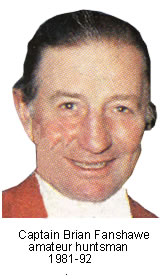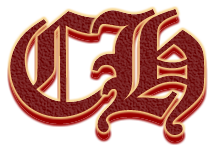Hounds
Michael Clayton, former editor and hunting correspondent of Horse & Hound magazine, describes below the breeding policy and the major bloodlines of the Cottesmore's distinctive hounds. Michael's new “History of Peterborough Royal Foxhound Show” is published by Quiller Press on July 19, 2006 at £25. (Quiller Press, Wykey House, Wykey, Shrewsbury SY4 1JA, tel: 01939 2616; e-mail info@quillerbooks.com. Previous hunting books by Michael Clayton include: “A Hunting We Will Go”, “The Chase”, “The Golden Thread”, “Foxhunting in Paradise” (which includes a history of the Cottesmore), “Endangered Species” and “The Glorious Chase - a Celebration of Foxhunting”
The Cottesmore pack has always been bred entirely for work, and this has been a major factor in the Hunt’s long record of excellent sport.
Some Hunts were criticised in the early 20th century for breeding with the show ring in mind, but the Cottesmore was certainly not among these. Success in the hunting field was the absolute priority for Cottesmore Masters and huntsmen. Since Peterborough Royal Foxhound Show began in 1878, the Cottesmore has won one championship: Baffle (’78) was bitch champion in 1979.
Like most other leading packs, the Cottesmore was bred on traditional lines in the 19th and early 20th centuries, relying frequently on sires from the Belvoir, Brocklesby and Fitzwilliam. The Belvoir was then regarded as the fount of “pure” English breeding.
Early photographs of the Cottesmore hounds show them in the Belvoir “livery” of black, tan and white, similar to the appearance of the neighbouring Shires packs.
Between the two world wars there began a gradual revolution in hound breeding, with introductions of Welsh blood into some English packs, despite fierce opposition from traditionalists. The aim was to produce lighter, more athletic hounds, and with low scenting abilities. In the postwar years the Cottesmore was one of the packs where traditional black, tan and white gave way to lemon and white hounds, some of them broken coated through Welsh outcrosses.
The Cottesmore pack was fortunate when Major “Chatty” Hilton-Green took the Mastership from 1931-46. As one of the outstanding huntsmen of his time, he took the closest interest in hound breeding, and was a friend of the 10th Duke of Beaufort, Sir Peter Farquhar, Ikey Bell of the South and West Wilts, and others who were among pioneers to experiment with Welsh outcrosses in the 1930s.
Hilton-Green bred a pack that was indeed athletic and active in the hunting field, enabling him to provide superlative sport in the years up to the war when Leicestershire and Rutland remained a sea of grass.
He was succeeded in the postwar years by leading amateur huntsmen who were able to take advantage of the growing trend towards English hounds invigorated with Welsh and other outcrosses.
The greatest change occurred during the highly successful Mastership of Capt. Simon Clarke, Joint Master and huntsman from 1969-76. He was brought up in the heartland of modern foxhound breeding: his step-father, Major Gerald Gundry, was Joint Master of the Duke of Beaufort's, and the Major hunted the doghound pack. Simon Clarke had already achieved much at the South Dorset, well known as a successful “modern” pack, along with its neighbour, the Portman, where Sir Peter Farquhar had created some of the most sought after postwar lines.
Simon Clarke set about “modernising” the Cottesmore pack with blood-lines from Badminton, the Heythrop, his former South Dorset kennel and elsewhere . At the Heythrop Capt. Ronnie Wallace proved a genius in producing hounds which were brilliant in their work, and able to win on the flags at Peterborough and the other leading hound shows, although he did not rely on Welsh outcrosses.
Simon Clarke used sires including the Duke of Beaufort’s Watchman (’65), Grocer (’68), and Falcon (’68), and the Heythrop Clinker (’66) Player (’68) and Luther (’67), Berkeley Briton (’63), and VWH Presto (’67). The former South Dorset Master’s reliance on “new” breeding was emphasised when he used Mandrake (’69), bred by Sir Newton Rycroft at the New Forest where he was renowned for experimentation in out-crosses. The Cottesmore was among packs to use the New Forest sire, Medyg (’69) by the Plas Machynlleth sire Miller (’63), perhaps the most renowned postwar example of Welsh outcross breeding.
Simon Clarke’s breeding policies were adhered to by the next Mastership after his departure in 1976. The 1979 Peterborough bitch champion Cottesmore Baffle (’78) derived from his influence, but her success would not have been achieved without the excellent work of Joint Master Mrs Di Hellyer who took great care to ensure that consistent breeding of a high standard was maintained in the Cottesmore kennel after Capt Clarke’s departure.
The Cottesmore’s Peterborough champion, Baffle (’78) was by Lambton (’73), a son of Cotswold Wiseman (’69), and Baffle’s dam was Bridesmaid (’73), daughter of South Dorset Bridegroom (’70).
A further policy of out-cross breeding arrived with the Mastership of Capt. Brian Fanshawe (1981-92) from the North Cotswold.
In the Cottesmore kennel he used Welsh lines through the stallion hound North Cotswold Craven (’78) going back to the Curre sire Saucy (’47) who was used in the North Cotswold kennel by Brian’s parents, Major and Mrs R.G. Fanshawe in the early postwar years.
Further Welsh blood came to the Cottesmore from the Bicester and Warden Hill kennel where Brian’s cousin, Capt. Ian Farquhar was Joint Master and huntsman. Bicester Granby (’88), by Cotswold Grappler (’85) was used in the Cottesmore kennel.
On the bottom line, this introduced Welsh blood going back to the Bicester’s influential dam Fairy (’73), drafted from the Vale of Clettwr. This line tended to reproduce marked broken coats, or “woollies”, and these became more evident in some hounds in the Cottesmore pack during Brian Fanshawe’s Mastership.
Not everyone in the Shires approved of these “woolly” hounds, but they had to admit that the Captain had bred an effective working pack that produced remarkably good sport, especially in the early part of drier seasons when scenting conditions were unhelpful in Leicesteshire and Rutland.
During his previous Mastership at the Warwickshire, Brian Fanshawe acquired a couple of whelps out of Carlow Stylish (’63), from the Irish pack that disbanded in 1965. Its hounds were warmly recommended for their working properties by Peter Farquhar.
“They are terribly easy to handle, nearly like pet dogs,” Brian Fanshawe said; “They need plenty of hunting, but they are biddable, and they have what Sir Peter Farquhar called ‘fox sense’.”
Fanshawe maintained the Carlow line at the North Cotswold and at the Cottesmore where 40 per cent of the pack had Carlow blood on the bottom line at the end of his Mastership in 1992. During his Cottesmore Mastership he also contributed much to the kennel through the use of leading sires, such as Duke of Beaufort’s Palmer (’83), Exmoor Dancer (’84) and Cotswold Grampian (’85).
Brian Fanshawe made a bold excursion into American hound breeding when his friend Ben Hardaway III, Master and huntsman of his famous Midland pack in Georgia USA, sent over a crossbred puppy whose breeding included American lines and lines from the Heythrop, Taunton Vale harriers and Ireland’s West Waterford pack. After a period in quarantine, the doghound was entered into the Cottesmore pack as Hardaway (’89); he sired several Cottesmore litters, including one at the end of his first season and three-and-a-half couple entered in 1995, out of Fancy (’92) by Bicester Granby (’88) containing Welsh blood. Hardaway also sired the much used Bicester Faraday (’95), and his progeny were much vaunted by the Cattistock, Cotswold and Meynell packs.
The new outcrosses were highly distinctive at first, but were noted as exceptionally low scenting and enthusiastic hunting hounds, qualities endorsed by Neil Coleman who hunted the Cottesmore pack after Fanshawe’s departure in 1992.
The American line remains in the Cottesmore kennel, and has contributed to its effectiveness as a working pack.
Policies in recent seasons up to 2006 have varied somewhat, but a recent higher emphasis on using Heythrop and Beaufort lines has strengthened the pack’s identity as an example of the modern trend in hound breeding, while occasional broken coats are evidence of the Welsh origins in parts of the pack.
The Cottesmore pack has been achieved through more than 200 years of careful, selective breeding aimed at achieving consistently good sport in one of the acknowledged great hunting countries of England.
The Hunt is determined to preserve and enhance its pack of hounds despite the imposition of the iniquitous Hunting Act in February 2005.
 As Michael Clayton described above, distinguished amateur huntsman Brian Fanshawe made significant changes to the Cottesmore's hound breeding policy during 1981-92 with further introduction of Welsh blood – a process started a few years earlier by Captain Simon Clarke. Here he explains what he was trying to achieve.
As Michael Clayton described above, distinguished amateur huntsman Brian Fanshawe made significant changes to the Cottesmore's hound breeding policy during 1981-92 with further introduction of Welsh blood – a process started a few years earlier by Captain Simon Clarke. Here he explains what he was trying to achieve.
Every serious huntsman always tries to improve his hounds and, perhaps, the most important factor is to produce a pack that is physically and mentally level. To achieve “levelness” I retained five female lines and each year I went nap on a single stallion hound. It stands to reason if you put the same stallion hound on litter sisters you are likely to get similar progeny.
To make my point the Cottesmore entry of 1981, that I inherited at the start of my mastership, involved six different stallion hounds. Entries during my time were seldom got from more than three.
Di Hellyer kindly let me use N Cotswold Stanway 76 in the last year of her mastership. He came from the Carlow ST line, which I so treasured ever since 1965 when I introduced it into the Warwickshire and took with me to Galway, N Cotswold and Cottesmore. I like to think Neil Coleman is an equal fan.
The “woollies” were actually introduced to the Cottesmore by Simon Clarke when he used New Forest Medyg 69. I made a lot of use of his grandsons Meddler and Merryman 80. Five of the seven litters entered in 1986 were by either Meddler or Merryman out of ST dams.
N Cotswold Craven 78 was another dog I brought with me and used. He had Welsh blood, with a female line going back to Sir Edward Curres's famous white hounds. Craven was a fantastic jumper and quickly taught the other hounds that they had to jump to stay with him. I like to think that Craven vastly improved the agility of the whole pack.
In 1988 during a visit to the Midland Hunt in Georgia, their famed Master Ben Hardaway gave me an American cross-bred whelp, who I entered in 1989 as Hardaway. From the gift I was looking to improve “nose” (scenting ability). Hardaway, the hound, certainly had the best nose of any hound that I hunted and all the huntsmen who have hunted his progeny bear this out.

